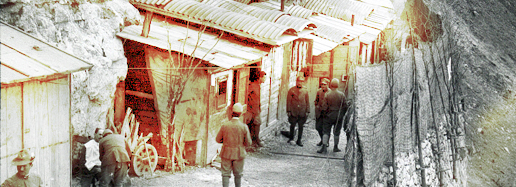|
Within the sphere of the complex and at times contradictory events that characterized the course of the First World War on the Italian front, the territory of the Vicentine Highlands constitutes without a doubt for its topographical characteristics, for its strategic value and most of all for the moral and psychological repercussions of the events that have unrolled in it, a sector of primary importance as much as to influence at one point, the entire conflict process. This geographically homogenous context was the only one on the entire front to constantly and uninterruptedly suffer for all of the forty one months of the conflict, the fate of a belligerent state culminating with the great "Offensiva di Primavera" ("Spring Offensive") better known with the name of "Strafexpedition" triggered by the Austro-Hungarians on May 1916 alongside the Trentine salient top of the Vicentine Pre-Alps, between the course of the Adige to the west and of the Brenta to the east.

It was probably the largest mountain battle ever fought and the most important military attempt, aside from the desperate offensive of 1918 carried out by the Habsburg Empire to definitely destroy the Italian army.
The objective and scope of the impressive offensive, cultivated with unfounded perseverance by the chief of the imperial army general staff field marshal Franz Conrad Von Hoetzendorf, consisted in the execution of a breaking attempt of the pre-alps front, between Pasubio and Brenta with central axis alongside the Astico Valley, with subsequent lead into the plain and with the city of Vicenza as a primary objective.
On a general strategic level, this would have precluded the retreat possibilities, from the Adige to the Po, of a large part of the Italian army deployed in Cadore and most of all on the Isonzo front, as to inflict to Italy a decisive defeat and as such, to eliminate it from the European conflict.
The historical-military causes are of fundamental importance for the comprehension of this extraordinary event that in the moment of its highest widening, namely in the first ten days of June 1916, witnessed in the opposition carried-out on the mountains of the Vicentine Pre-Alps between Adige and Brenta something like 400,000 Austro-Hungarians lined-up before 600,000 Italians: the almost unbelievable reality of one million men, with related animals and machineries, on a territory nearly lacking any possible resource for daily nourishment.
This enormous military presence replaced in many cases the civilian population, that was experiencing just as much agonizing suffering; first of all, for those coming from the valley of Posina and from the middle Astico, from the Tonezza highlands and from the Sette Comuni, forced to rashly and desperately run away towards the valley after having abandoned even the most modest possessions.
The tragedy of the refugees represented a terribly dramatic moment, the testimonies of the harrowing images and aspects were revealed by the very same soldiers which were headed towards distressed defense positions.
|

|

|